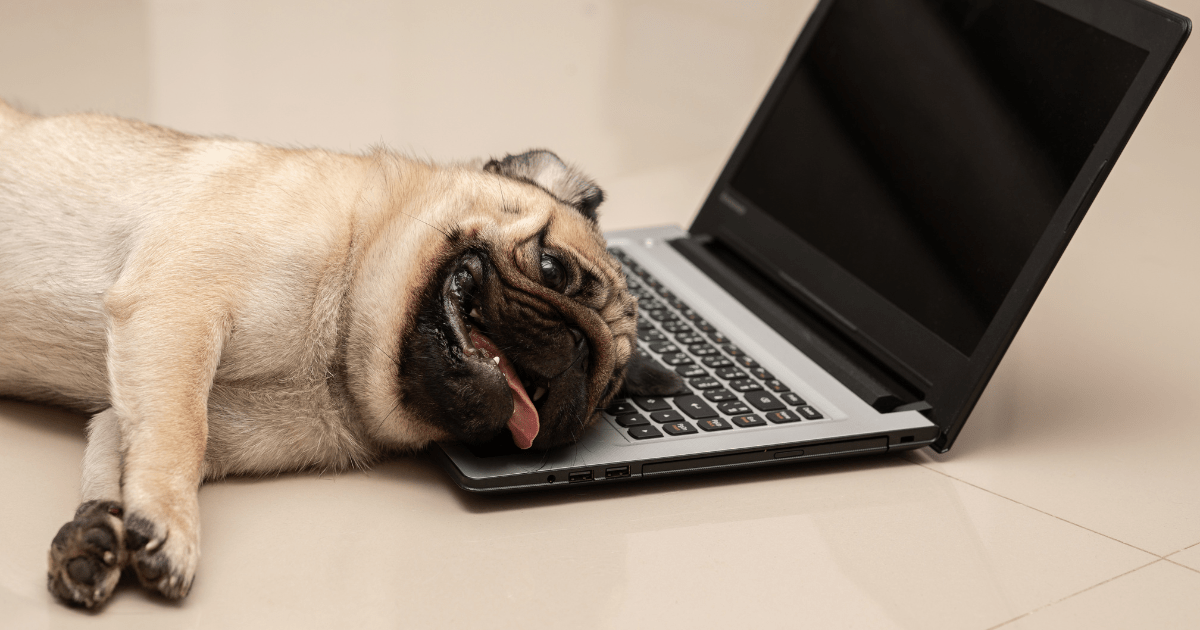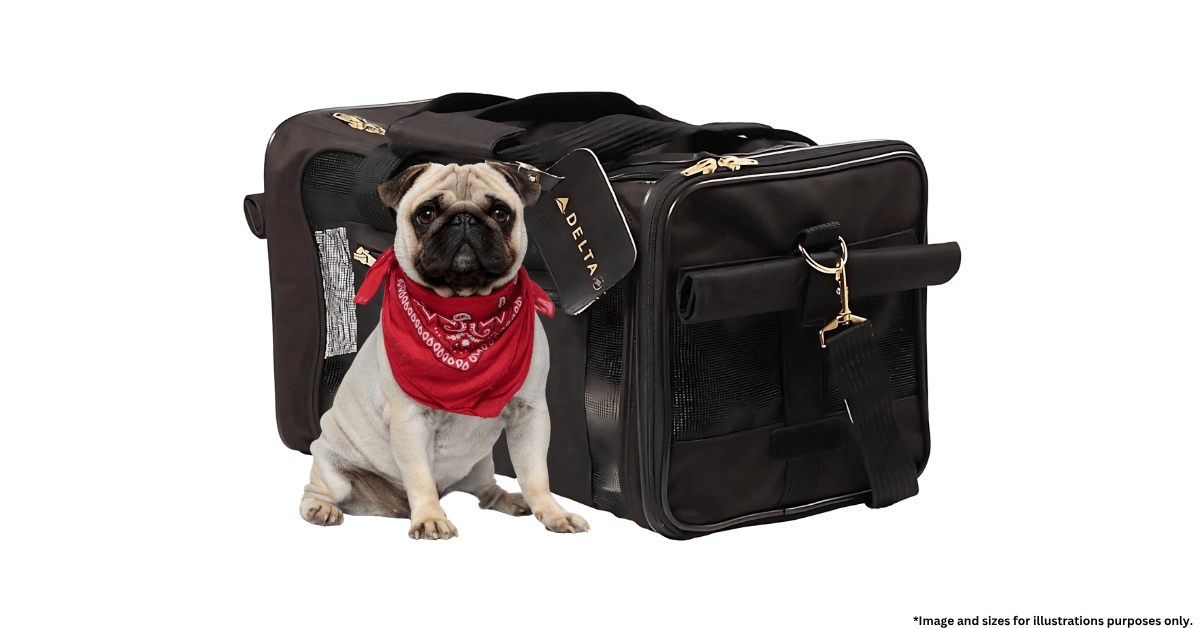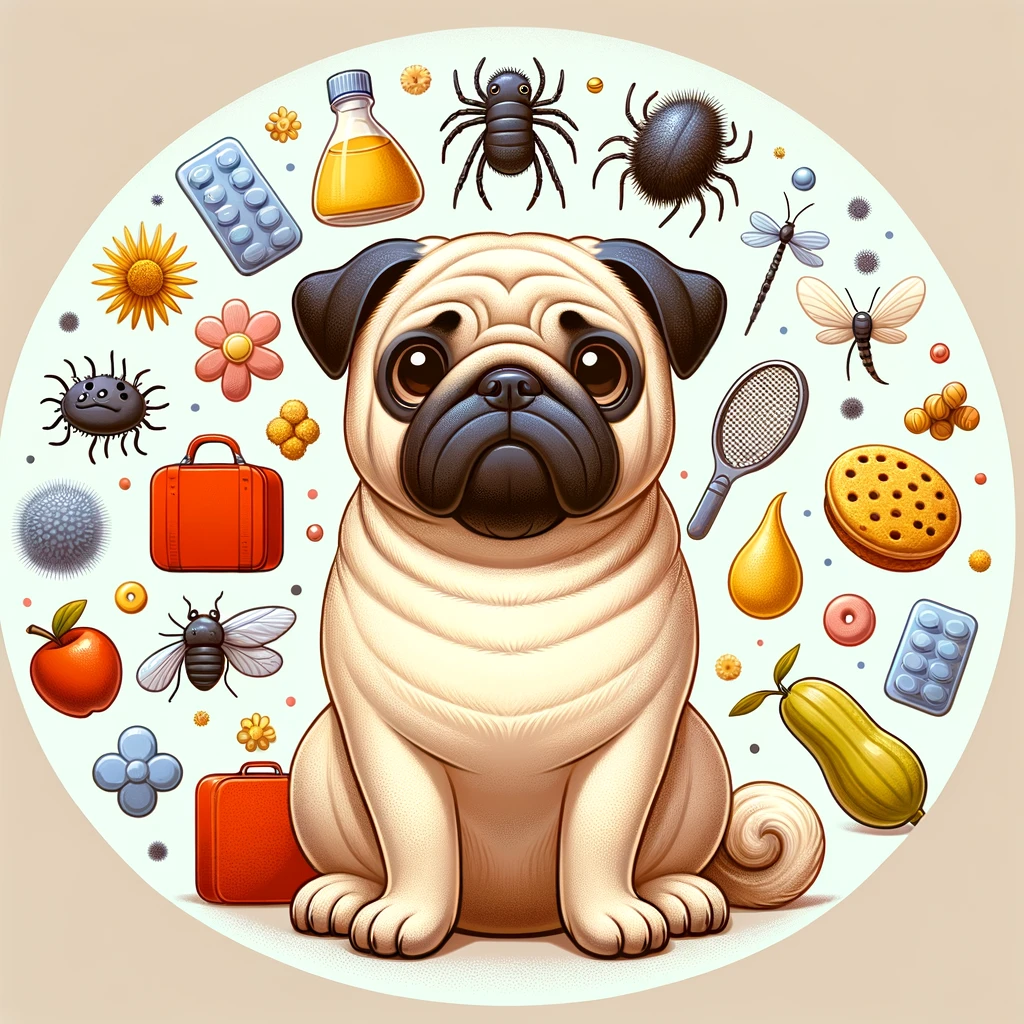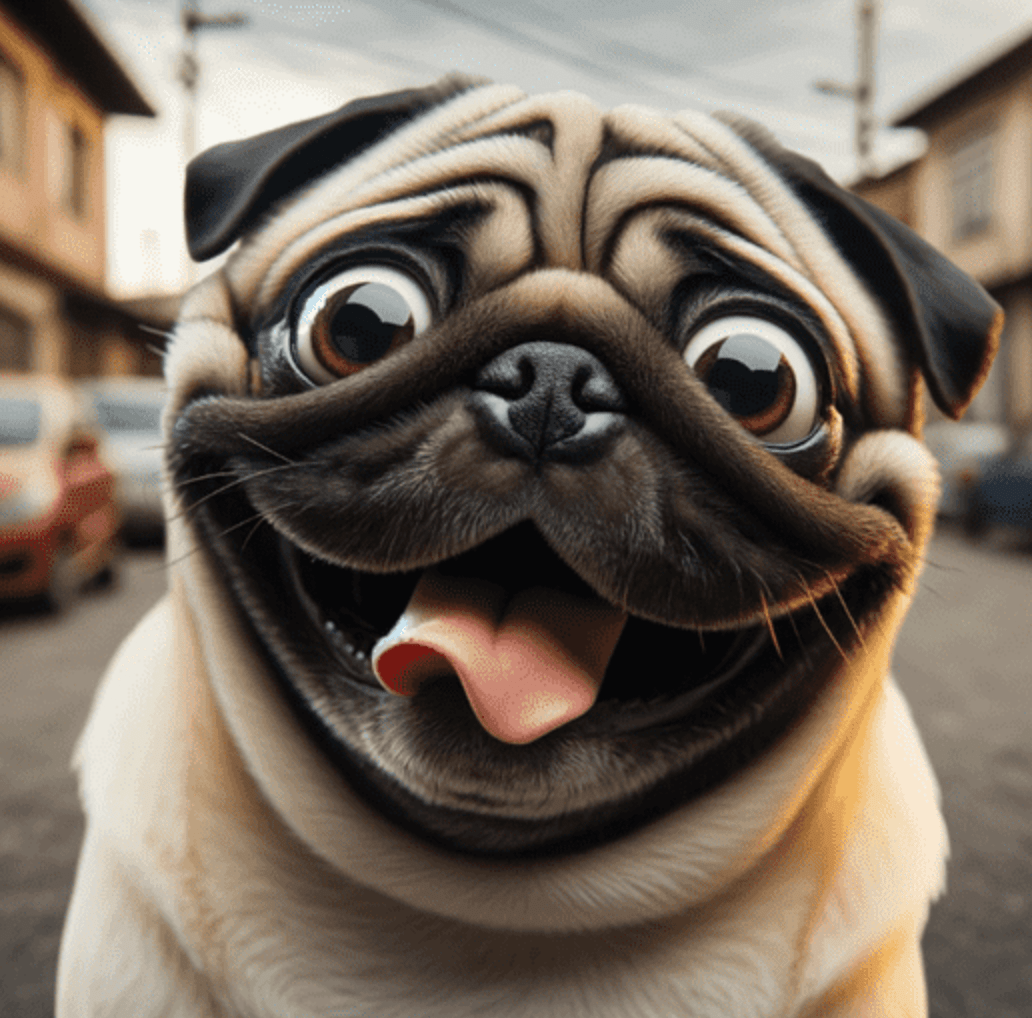Pugs—those charming, wrinkled dogs with expressive faces—are not just adored for their playful personalities but also for their noble origins. Throughout history, pugs have been more than just pets; they have been companions of emperors, royalty, and aristocrats. With roots tracing back to ancient China, these lovable dogs have traveled across continents, becoming symbols of loyalty, luxury, and status. But what is the true story behind the noble origins of pugs, and how did they rise to such esteemed positions throughout history?
In this article, we will explore the noble origins of pugs, taking you back to their beginnings in ancient China, where they were esteemed as royal companions and symbols of good fortune. This blog post serves as an exclusive overview of Chapter 1: The Noble Origins of Pugs from our eBook. It offers a sneak peek into the fascinating world of pugs, filled with historical insights, delightful anecdotes, and a touch of humor. If you’re a pug enthusiast or just curious about the breed’s history, this is the perfect read for you!
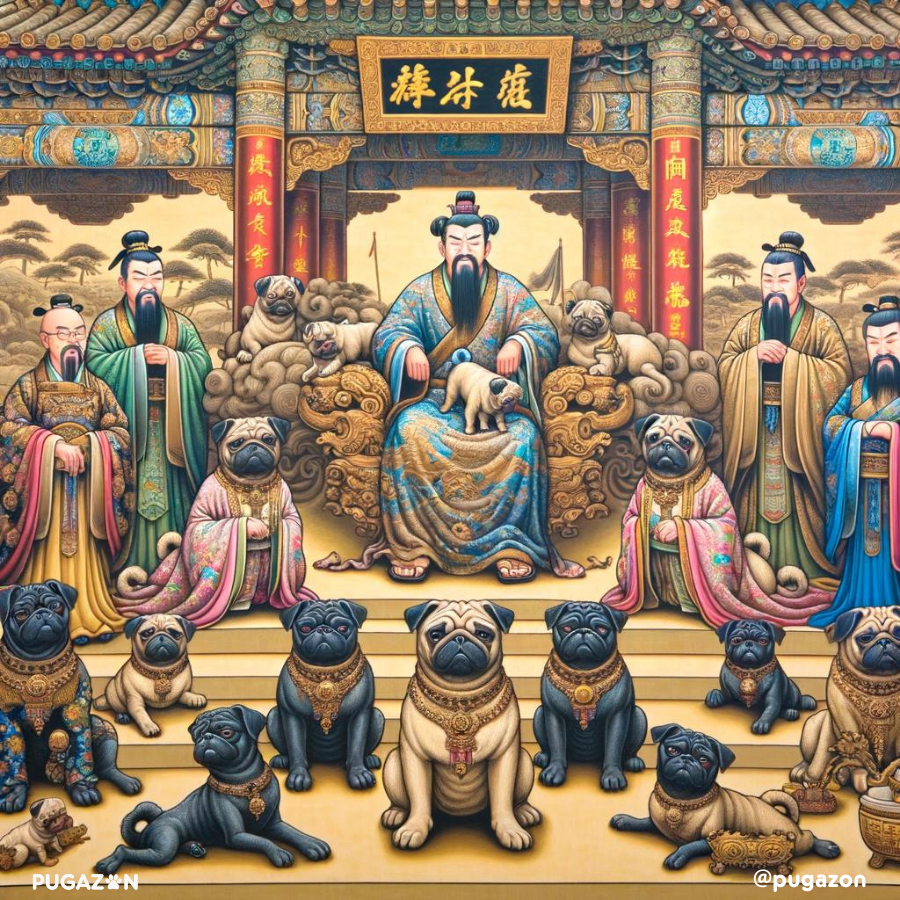
Why Focus on Pugs' Origins?
Understanding the origins of pugs provides a unique insight into their enduring popularity and why they remain a favorite among dog lovers today. From the palaces of ancient China to the modern living rooms of pug lovers around the globe, these dogs have charmed their way into the hearts of many. By exploring their royal beginnings, we can better appreciate their unique qualities and the reasons behind their celebrated status.
Join us as we delve into the rich history of pugs, revealing how they went from being cherished companions of emperors to one of the world’s most popular breeds. And for those eager to learn more, our eBook offers a deeper dive into the captivating journey of pugs through history. Don’t miss out—grab your copy today!
Let’s embark on this journey through time and uncover the noble origins of pugs.
"In the opulent courts of ancient China, pugs were not just pets—they were royal icons. Their every need was attended to by palace servants, and they were even known to have their own palatial quarters. Such was the life of a pug—pampered, adored, and always by the side of the emperor."
The Noble Origins of Pugs: A Historical Overview
The Mysterious Beginnings: Tracing the Origins of Pugs
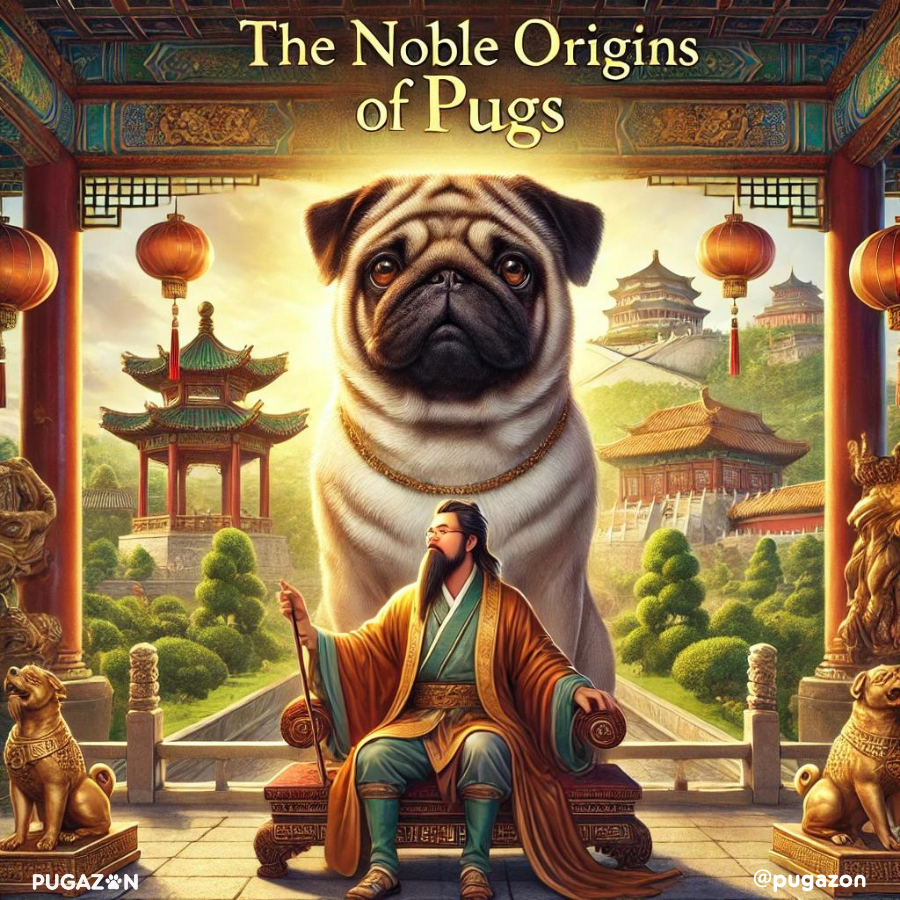
The exact origins of pugs are shrouded in mystery, much like the mist-covered mountains of ancient China where their story began. While some believe that pugs may have been around as early as 400 BCE, bred from smaller breeds or perhaps even descended from the Tibetan Mastiff, one thing is clear: pugs have always been associated with royalty and prestige.
In ancient China, pugs were highly prized for their distinct appearance—flat faces, large, soulful eyes, and a compact, muscular build. These traits, combined with their friendly and affectionate temperament, made pugs the perfect companions for Chinese emperors and their families. Unlike other dogs that were bred for hunting or guarding, pugs were bred to be lapdogs, providing comfort and companionship to their royal owners. Their size, demeanor, and even their facial expressions were meticulously cultivated to align with the ideals of beauty and nobility held by the Chinese court.
A Symbol of Loyalty and Good Fortune
Beyond their roles as cherished pets, pugs also held significant cultural symbolism. They were considered symbols of loyalty, fidelity, and good fortune—qualities that were highly valued in Chinese society, especially among the aristocracy. The belief that a pug’s wrinkled face resembled the Chinese character for “prince” added to their allure, as it was seen as a sign of their royal status and good luck.
Pugs were more than just pets; they were spiritual companions. Their presence was thought to bring harmony and positive energy into the home, making them more than mere animals. Emperors and empresses treated their pugs with the utmost care, ensuring they lived in the lap of luxury, literally and figuratively. They were fed the finest foods, dressed in specially tailored garments, and even had their own attendants. This exceptional treatment reflected not just the pugs’ perceived importance but also the status and power of their owners.
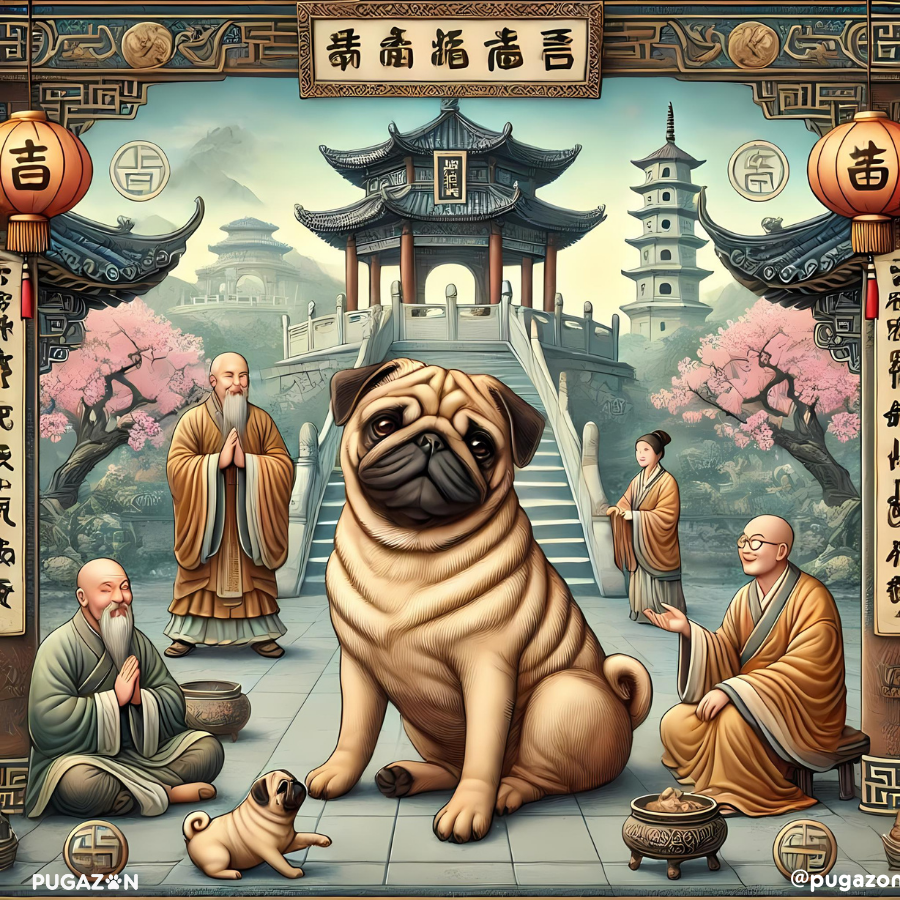
Pugs in Ancient China: The Royal Companions
Life in the Imperial Court: More Than Just Pets
In ancient China, pugs were more than just beloved pets—they were esteemed members of the imperial court. These dogs, with their distinctive flat faces and small, sturdy bodies, often occupied a place of honor at the feet of emperors and empresses, serving as both companions and symbols of prestige. The pug’s presence in the royal household was a reflection of the emperor’s wealth and power, reinforcing the dynasty’s prosperity and divine favor.
Pugs were integrated into the very fabric of court life, enjoying privileges that many humans could only dream of. They were given honorary titles, lavished with luxurious gifts, and even had their portraits painted by court artists. These paintings often depicted the pugs alongside dragons and phoenixes, emphasizing their importance and the divine protection they were believed to offer their owners. The close bond between pugs and their royal masters was a source of fascination and envy among the courtiers and visiting dignitaries alike.
Royal Treatment: The Luxurious Lives of Pugs
The life of a royal pug in ancient China was one of extraordinary luxury and care. These dogs lived in specially designed quarters within the palace grounds, complete with silk-lined beds, gold-plated feeding bowls, and dedicated attendants who catered to their every whim. Pugs were often dressed in miniature versions of the robes worn by the emperor, symbolizing their high status and close association with royalty.
There are tails of a historical pug known as “Golden Lotus,”. This pug lived the life of royalty andwas said to have her own private garden within the palace, where she was free to roam among carefully tended flowers and trees. Her meals were prepared by the imperial chefs and consisted of the finest meats, rice, and vegetables, ensuring she was always in peak health. The empress’s affection for Golden Lotus was so profound that she often brought the pug with her to state functions, much to the amusement and admiration of foreign diplomats.
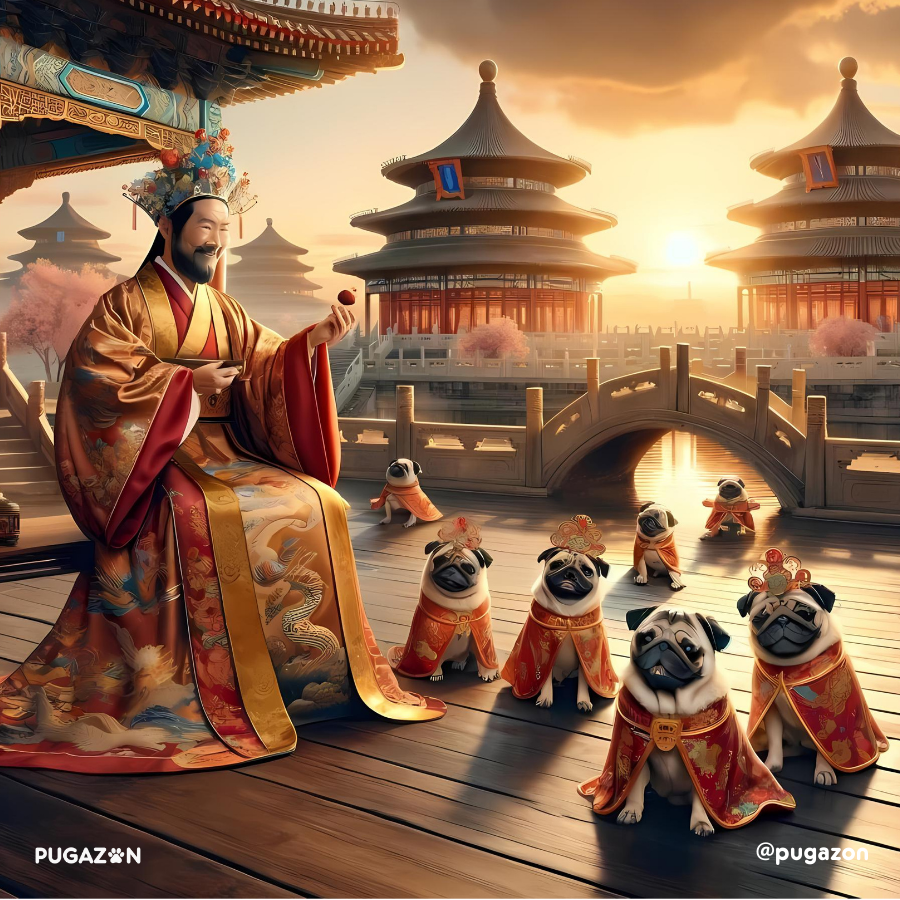
Pugs as Symbols of Wealth and Power
Beyond their roles as cherished companions, pugs also served as powerful symbols of the emperor’s wealth and influence. Owning a pug was a privilege reserved for the highest echelons of society, and these dogs were often presented as diplomatic gifts to visiting dignitaries and foreign royalty. The gifting of a pug was considered a gesture of great honor and respect, symbolizing the strength of alliances and the favor of the Chinese emperor.
This practice of gifting pugs played a significant role in the spread of the breed beyond China’s borders. As European traders and diplomats began to forge closer ties with China, they were frequently gifted pugs as tokens of goodwill and cultural exchange. These small, charming dogs quickly won the hearts of European nobles, who were captivated by their unique appearance and royal lineage. This marked the beginning of the pug’s journey from the imperial palaces of China to the grand courts of Europe.
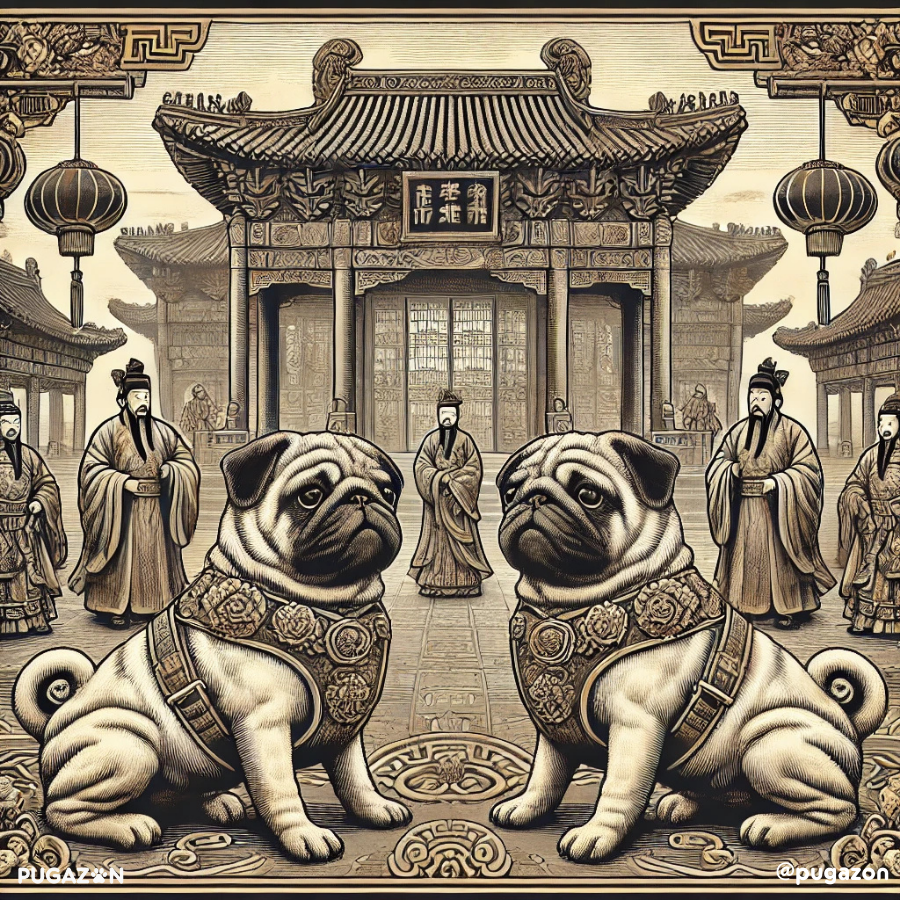
Last update on 2025-02-11 / * Affiliate links / Image source: Amazon Product Advertising API
The Journey of Pugs from East to West
How Pugs Traveled the World: From Ancient China to Europe
While pugs were firmly established as cherished members of Chinese imperial life, their journey beyond China began in earnest during the 16th and 17th centuries. European traders, particularly the Dutch, were among the first to encounter pugs in the palaces of China. These traders quickly recognized the value of these unique dogs, not only as charming companions but also as exotic gifts that could curry favor with European nobility.
The Dutch East India Company, the dominant trading power at the time, was instrumental in introducing pugs to Europe. Dutch merchants would bring pugs back to Holland, presenting them as gifts to Dutch nobility and the House of Orange. The breed quickly gained popularity in Europe, particularly among the elite, who were enamored with the pug’s exotic origins and regal demeanor. From Holland, pugs spread to France, Spain, and England, where they continued to be associated with royalty and aristocracy.

Pugs in European Courts: The Royal Obsession Continues
In Europe, pugs quickly captured the hearts of the aristocracy and became symbols of loyalty, wealth, and refinement. The House of Orange in Holland, for example, became avid pug enthusiasts after a pug named Pompey reportedly saved the life of William the Silent, Prince of Orange, by alerting him to an approaching assassin. This act of loyalty endeared pugs to the Dutch royal family and further cemented their status as royal companions. In France, Queen Marie Antoinette was known for her love of pugs, keeping a beloved pug named Mops. Similarly, in England, pugs became the preferred breed of Queen Victoria, who owned many pugs and even established a breeding program. The fascination with pugs spread throughout Europe, with the breed often featured in royal portraits and depicted alongside their noble owners in paintings and sculptures, showcasing their esteemed status within European society.
The Role of Pugs in Diplomacy and Cultural Exchange
The spread of pugs from China to Europe was not only a testament to their charm but also played a significant role in diplomacy and cultural exchange. The gifting of pugs as diplomatic offerings helped to establish and strengthen relationships between nations. Their unique appearance, combined with their royal association, made them highly desirable in European courts, where they were seen as symbols of cultural sophistication and elegance.
As pugs became more common in European courts, they also became symbols of a new era of global exploration and cultural exchange. The breed’s journey from the imperial palaces of China to the aristocratic halls of Europe reflects the broader patterns of trade, diplomacy, and cultural diffusion that characterized the early modern period. Pugs, in this sense, were more than just pets—they were ambassadors of a new, interconnected world.
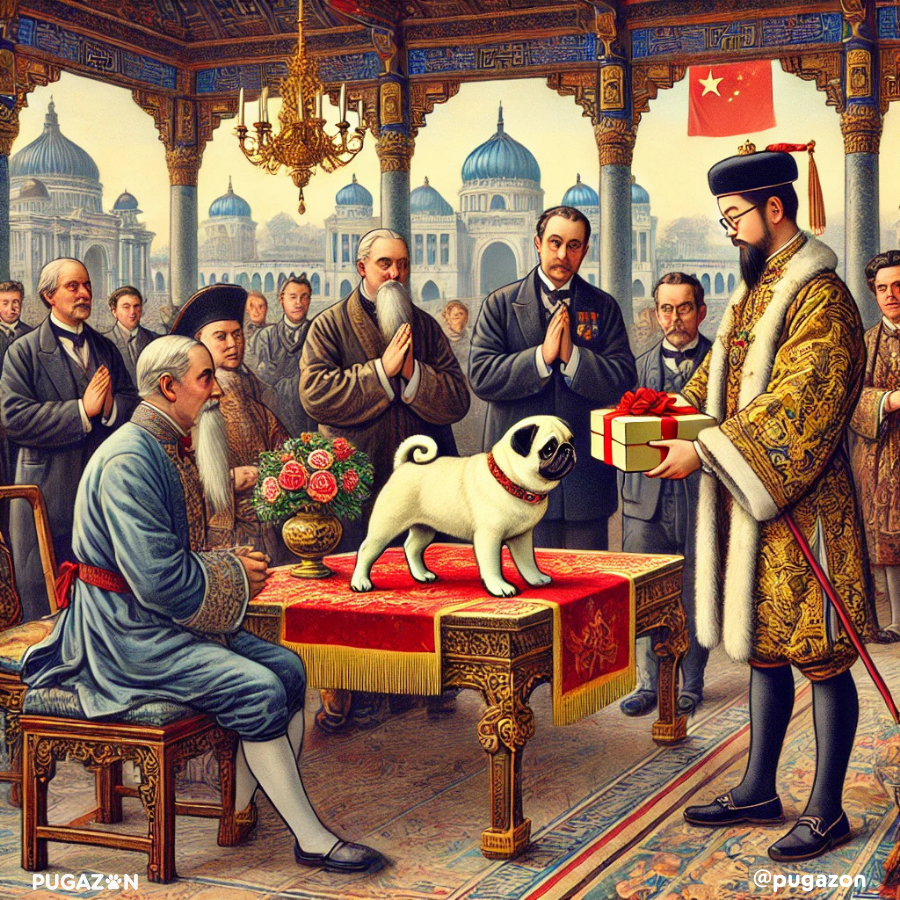
"Pugs were more than just pets in the Chinese imperial court—they were symbols of divine favor and royal power, beloved companions who enjoyed privileges that few could ever dream of."
Modern Perceptions of Pugs: A Legacy That Endures
From Ancient China to Today: Why Pugs Remain Popular
The pug’s journey from the palaces of ancient China to the cozy homes of modern dog lovers is a testament to their enduring appeal. Over the centuries, pugs have captured hearts worldwide, thanks to their charming personalities, distinctive looks, and undeniable charisma. But what is it about pugs that have made them so popular, both in the past and today?
Modern pug enthusiasts often cite the breed’s playful yet affectionate nature as a key reason for their popularity. Pugs are known for their loving temperament and their ability to bond closely with their owners. They are often described as “shadows” that follow their humans everywhere, always eager to be part of the action. This loyal and affectionate nature can be traced back to their origins in ancient China, where they were bred specifically to be companions to royalty.
Additionally, the pug’s unique appearance—characterized by their wrinkled faces, large, expressive eyes, and distinctive snub noses—continues to capture attention and admiration. These features, which were carefully cultivated by ancient breeders, remain a hallmark of the breed today. Their compact size and adaptable nature also make them well-suited for modern living, particularly in urban environments where space may be limited.
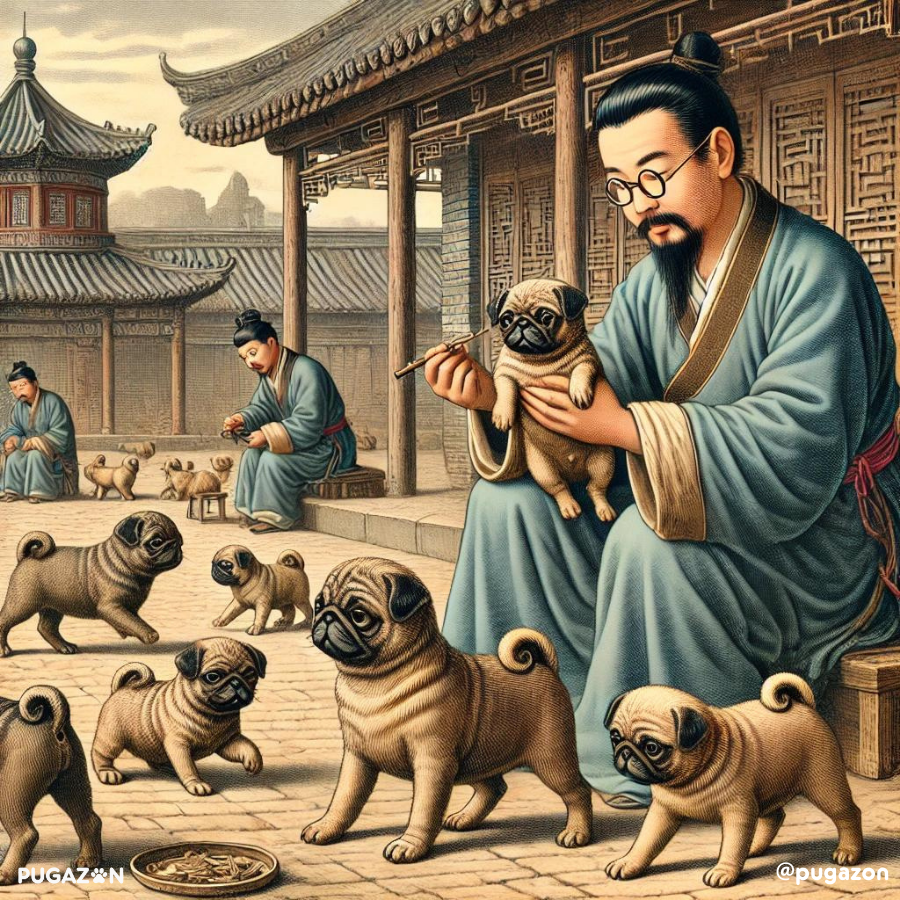
Pugs in Pop Culture and Social Media
In the digital age, pugs have found a new platform to shine: social media. With their expressive faces and quirky personalities, pugs have become internet sensations, featured in countless memes, videos, and social media accounts. Celebrities and influencers often showcase their pet pugs, further fueling the breed’s popularity. Pugs are also frequently seen in movies, television shows, and advertisements, where their distinctive looks and comedic charm make them a hit with audiences.
This modern fascination with pugs is not a new phenomenon but rather a continuation of the breed’s historical appeal. Just as they once graced the imperial courts of China and the aristocratic salons of Europe, pugs now capture the digital spotlight, proving that their appeal truly transcends time and culture.
Always Stay Up to Date
The Evolution of Pug Care: From Ancient Times to Modern Day
Pug Care Through the Ages: What Has Changed?
Caring for a pug today is vastly different from how these dogs were cared for in ancient times. In the imperial courts of China, pugs were treated with extraordinary care and attention. They were fed specially prepared meals, often consisting of the finest meats and rice, and had dedicated attendants who ensured their every need was met. Grooming was an elaborate affair, with pugs often bathed in scented water and brushed with silk to maintain their coats. These practices were a reflection of the pug’s esteemed status and the belief that they were not mere animals but almost divine companions.
Today, while pug care may not involve palace attendants or custom-made meals, the breed still requires special attention, particularly when it comes to their health. Pugs are prone to specific health issues, such as breathing difficulties due to their brachycephalic (short-nosed) structure, as well as skin conditions due to their folds. Modern pug care emphasizes regular veterinary check-ups, a balanced diet, and proper exercise to maintain a healthy weight and reduce the risk of respiratory issues.

Modern Best Practices for Pug Owners
- Diet and Nutrition: Unlike their ancient counterparts, modern pugs benefit from specially formulated dog food that meets their unique nutritional needs. A balanced diet helps manage their weight and supports overall health, particularly joint and respiratory health.
- Regular Exercise: While pugs are not high-energy dogs, they do need regular exercise to prevent obesity, a common issue due to their love of food and relatively sedentary nature. Short walks and playtime are ideal.
- Grooming and Skin Care: Pugs require regular grooming to keep their coats clean and to prevent skin infections in their folds. Regular cleaning of their facial wrinkles and ears is essential to avoid infections.
- Breathing Considerations: Due to their brachycephalic structure, pugs often have difficulty breathing, especially in hot or humid conditions. It is crucial to monitor their activity levels and provide a cool, comfortable environment to prevent overheating.
These practices reflect the evolution of pug care from the luxurious pampering of ancient China to the informed, health-conscious care of today. While the specifics may have changed, the underlying principle remains the same: pugs are cherished companions deserving of the best care we can provide.
A modern pug owner, frustrated by her pug’s tendency to overeat, decided to try a new feeding technique: placing a slow feeder bowl inside another slow feeder bowl. The result? Her pug stared at the contraption in bewilderment for several minutes before figuring it out. It was a brief victory for the owner but a lasting reminder of the pug’s persistence when it comes to food!
Why This Story Matters: Connecting Past and Present Pug Lovers
The history of pugs is not just a tale of royal lapdogs and luxurious palaces; it’s a story that connects generations of dog lovers, from ancient emperors to modern pet owners. Understanding the rich heritage of pugs allows us to appreciate their unique qualities even more, fostering a deeper bond between pugs and their owners. Our eBook, “The Ultimate Pug Guide – From Noble Origins to Modern Celebrities” offers a comprehensive look into this fascinating history, packed with exclusive content, rare anecdotes, and valuable insights.

What Makes Our eBook Unique?
- In-Depth Historical Insights: Learn about the noble origins of pugs in ancient China, their role in the imperial court, and how they became symbols of loyalty and good fortune. The eBook explores not only the historical facts but also the cultural significance of pugs, providing a richer understanding of their place in society.
- Rare Anecdotes and Stories: Discover lesser-known stories about famous pugs throughout history, from the pampered pets of Chinese emperors to the loyal companions of European nobility. These stories, often passed down through generations, highlight the unique bond between pugs and their owners.
- Valuable Insights on Pug Care: The eBook also includes practical advice on modern pug care, drawing from both historical practices and contemporary veterinary science. Learn how to provide the best care for your pug, ensuring a happy and healthy life.
- Engaging Visuals and Illustrations: The eBook features beautiful illustrations and photographs that bring the history of pugs to life, making it a visually engaging experience for readers.
Frequently Asked Questions About Noble Origins of Pugs
To further enrich your understanding of the noble heritage of pugs, here are some frequently asked questions specifically related to their history, cultural significance, and roles in ancient Chinese society, as highlighted in our eBook and this article.
Pugs were highly valued in ancient China, particularly among the imperial family, because of their distinctive appearance, affectionate nature, and symbolic significance. Their flat faces and large, expressive eyes were considered beautiful and unique, aligning with the aesthetic preferences of the time. Additionally, pugs were believed to bring good fortune and were seen as symbols of loyalty, making them ideal companions for royalty who valued fidelity and devotion.
Owning a pug was a privilege reserved for the highest echelons of society in ancient China. These dogs were not only seen as luxury pets but also as status symbols that represented the wealth and power of their owners. Pugs were often given as diplomatic gifts to visiting dignitaries, signifying the emperor’s favor and the strength of alliances. The breed’s royal association and exclusive ownership reinforced their image as symbols of prosperity and high status. (Refer to Section 3: Pugs in Ancient China: The Royal Companions for more insights.)
Pugs were much more than mere pets; they were integral to the cultural and social fabric of the Chinese imperial court. They were often included in important state functions and ceremonies, reflecting their status as cherished companions and symbols of imperial favor. Pugs were also frequently depicted in art and literature, reinforcing their cultural significance and the deep affection the Chinese aristocracy had for them. Their presence in the court served as a constant reminder of the emperor’s power, wealth, and divine right to rule. (Refer to Section 3: Pugs in Ancient China: The Royal Companions for more examples.)
The spread of pugs from China to Europe began during the 16th and 17th centuries when European traders and diplomats encountered these unique dogs in the Chinese imperial court. Recognizing their appeal, Dutch traders brought pugs back to Europe, where they quickly became popular among the aristocracy. The breed’s association with royalty and their charming appearance made them highly desirable pets in European courts, continuing their legacy as symbols of status and luxury. (Refer to Section 4: The Journey of Pugs from East to West for more on their global journey.)
Yes, ancient Chinese breeders were highly selective in their breeding practices, focusing on developing specific traits that were considered desirable, such as the pug’s flat face, compact body, and distinctive wrinkles. These traits were not only seen as aesthetically pleasing but also as indicators of the breed’s noble heritage. The careful and deliberate breeding practices of ancient China have significantly influenced the modern pug’s appearance, making them one of the most recognizable breeds today.
Understanding the history of pugs enriches the experience of owning one by providing context to their unique traits and behaviors. Knowing that pugs were bred for companionship and valued for their loyalty and affectionate nature helps modern owners appreciate these qualities even more. Additionally, recognizing the breed’s cultural significance and historical status as royal pets can deepen the bond between owner and dog, creating a sense of continuity with the past.
These FAQs provide a closer look at the historical and cultural significance of pugs, as well as their journey from royal companions to beloved modern pets. For more in-depth knowledge and exclusive content, don’t forget to check out our eBook. It’s the ultimate guide for anyone interested in the fascinating world of pugs!
Our eBook dives deep into these topics and more, offering a comprehensive exploration of pug history, care, and modern-day significance. Download your copy today and become an expert on one of the world’s most beloved dog breeds!
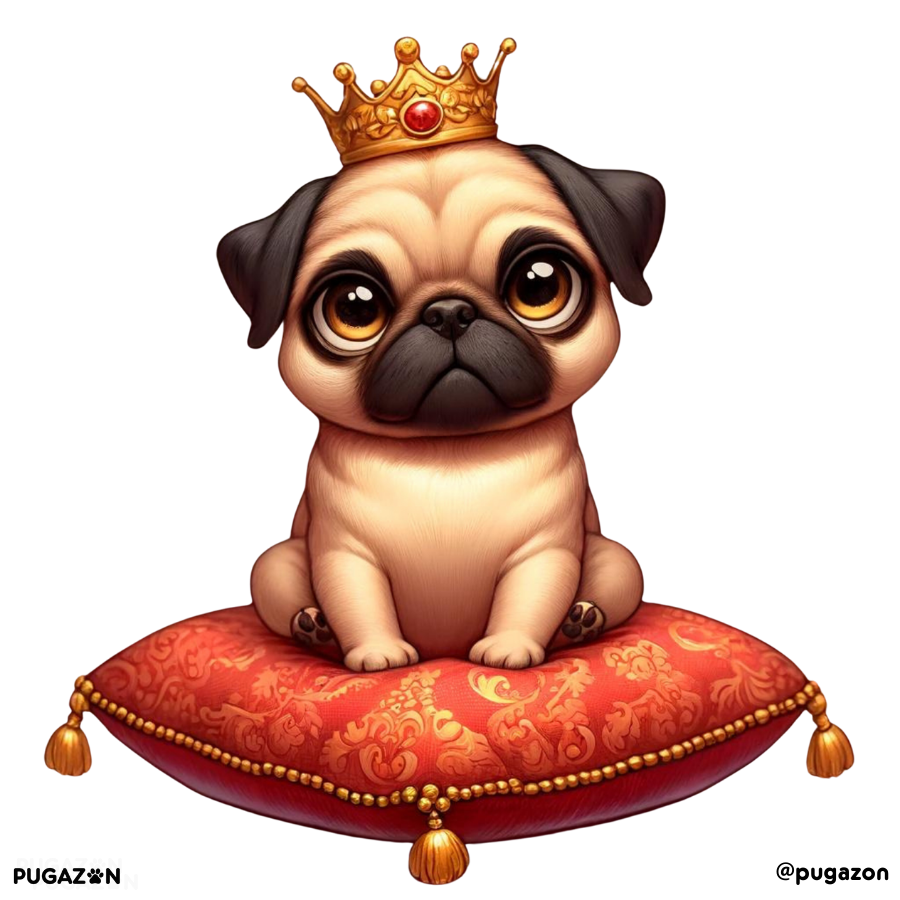
"The deep affection that ancient Chinese emperors had for their pugs is mirrored in the modern-day love that pug owners feel. It’s a bond that transcends time, rooted in loyalty, love, and a shared history."
Summary
Recap the Rich History and Cultural Journey of Pugs
The history of pugs is a fascinating journey that spans continents and centuries, from their noble beginnings in the imperial courts of ancient China to their beloved status in modern homes worldwide. These charming, wrinkled companions have not only warmed the laps of emperors and royalty but have also found a special place in the hearts of countless dog lovers.
Understanding the noble origins of pugs gives us a deeper appreciation for their unique qualities—both physical and temperamental—that have made them such enduring favorites. Pugs are more than just adorable pets; they are symbols of loyalty, good fortune, and a rich cultural heritage that continues to capture our imagination.
By exploring their historical significance, we see how pugs were not merely ornamental dogs of the elite but played a vital role in diplomacy, culture, and even humor within royal circles. Today, their popularity persists, fueled by their lovable nature, adaptability, and the same quirky charm that made them the darlings of the imperial courts.
We hope this deep dive into the noble origins of pugs has provided you with new insights and a greater appreciation for this delightful breed. Pugs have a unique way of bringing joy to those around them, whether they are snoring contentedly at your feet or playfully prancing around the house. If you’re a pug lover, share your thoughts and experiences in the comments below—we’d love to hear your pug stories!



